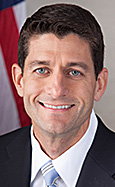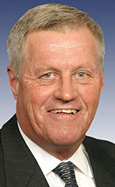Ryan budget would cut farm programs, block grant SNAP, cut LIHEAP
April 01, 2014 | 12:46 PM

Rep. Paul Ryan, R-Wis.
House Budget Committee Chairman Paul Ryan, R-Wis., today released a 15-year House budget resolution that would cut farm program spending by $23 billion between 2015 and 2024, turn the Supplemental Nutrition Assistance Program into a block grant to the states, and eliminate the provision that allows an increase in SNAP benefits if states use the Low-Income Home Energy Assistance Program to make payments of at least $20 per year per household.
As in past years, Ryan has entitled the budget “The Path to Prosperity.” A markup is scheduled Wednesday, but the budget is not expected to be enacted because the Senate is unlikely to pass a budget resolution this year.
The budget notes that the farm bill “reformed commodity programs, mostly notably by eliminating direct payments,” but also says, “However, this area remains ripe for reform.”
The budget says that “mandatory agricultural outlays, other than food and nutrition programs, will be reduced by $23 billion relative to the currently anticipated levels from fiscal year 2015 through fiscal year 2024. These savings could be achieved by continuing to reform assistance programs for agriculture.”
The budget also says, “Farmers will benefit greatly from other provisions in this budget, including regulatory relief, fundamental tax reform, and stronger economic growth as the burden of federal deficits is lifted from the economy.”
The resolution does not say exactly how farm programs would be cut.
As he has for the last several years, Ryan proposes turning the SNAP program into a block grant to the states, but once again it would make no changes to SNAP until 2019, when unemployment has presumably gone down.
The budget proposal also eliminates broad-based categorical eligibility that allows households to become eligible for SNAP by receiving a minimal Temporary Assistance for Needy Families fund benefit or service.
“Typically, an individual is made eligible by receiving a TANF brochure or being referred to a social services ‘800’ telephone number. This allows individuals to qualify for SNAP benefits under less restrictive criteria. For example, 40 states currently have no asset test for receiving SNAP benefits,” the budget says.
The proposal also notes that states make payments to households to increase SNAP benefits, but notes that that the farm bill required that this amount be increased to $20 per household per year.
“The recently passed farm bill reformed this practice, but it did not end the abuse entirely and this proposal would,” the budget says.

Rep. Collin Peterson, D-Minn.
House Agriculture Committee ranking member Collin Peterson, D-Minn., said in a statement, “The Ryan budget proposal is more of the same from a House majority that seems to prefer political messaging over achieving real results.”
“Turning SNAP into a block grant would only create an unaccountable black hole for federal dollars. The 2014 farm bill cut $13 billion from the farm safety net; yet the Ryan budget calls for an additional $23 billion cut in both farm and crop insurance programs, potentially jeopardizing farmers’ ability to produce a safe and affordable food supply,” Peterson said.
“I am committed to reducing our debt and working across the aisle in a serious and thoughtful manner to address our budget issues. Unfortunately, the hatchet approach taken by the Ryan budget proposal is neither serious nor thoughtful. As we most recently saw with the farm bill, Congress can work if members of both political parties come together. It’s going to take that kind of bipartisan effort if we are going to have a serious budget debate,” he concluded.
▪ The Path to Prosperty: Fiscal Year 2015 Budget Resolution ▪ — Summary Tables ▪ — Concurrent Resolution text